|
Monday, August 24, 2009
Progress Notes
A few weeks ago Debra Wolfe of The Lake Today periodical came to the museum to photograph the American Flag we have on display which originally had been placed on the casket of Carl Wenzel the day of his funeral December 8, 1978. Debra was gathering information in preparation for an Independence Day article about the American Flag for The Lake Today newspaper. I featured Debra’s visit on the previous Progress Notes of July 6 in which I also presented some information about Carl (photo 01).
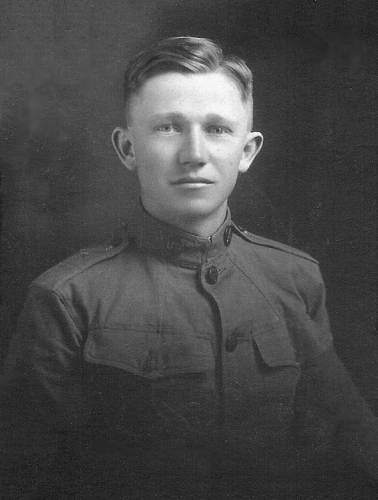
01 Carl Wenzel You can also read Debra’s article on The Lake Today website.
Carl Wenzel was the uncle of Miller County Historical Society board member emeritus Helen Heafey Schulte so Debra wanted to photograph Helen as well as the flag. Here is the photo Debra placed in The Lake Today article in which Helen is pointing to Carl’s name in a list of WWI Soldiers (photo 02).
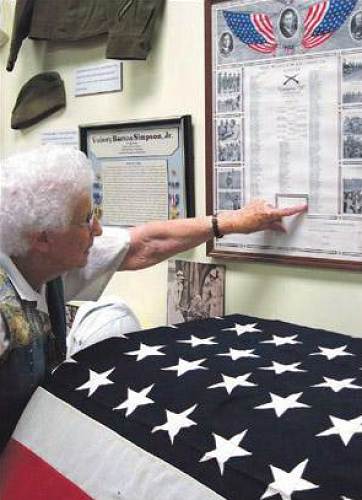
02 Helen Schulte While Debra was photographing Helen I photographed both of them (photo 03).
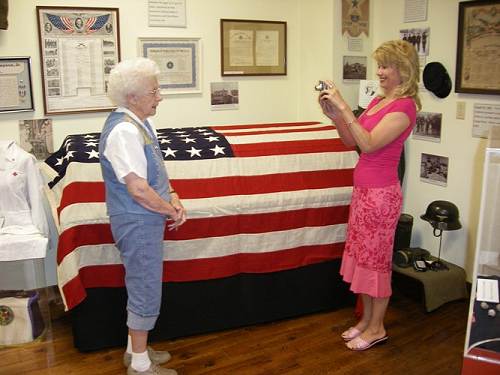
03 Helen Schulte and Debra Wolfe Helen is one of our Miller County history consultants. She is the most agile, active and alert past ninety year old person I have ever known (photo 04).
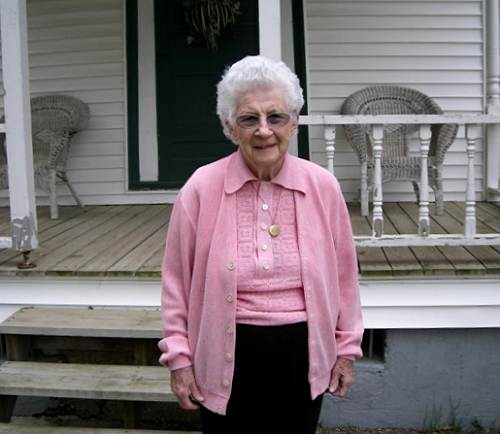
04 Helen Heafey Schulte Because she was a teacher (my sixth grade teacher) she has a natural interest in history, especially that of Miller County. I consult with her on a regular basis to inquire about historical Miller County events of the past, many of which she witnessed in person. I featured her on a previous edition of Progress Notes in which was discussed the history of her Century Farm where the very famous Skinner Tomb is located. Her grandfather, Daniel Heafey (photo 05), had purchased the farm from James Skinner (photo 06) at the turn of the last century.
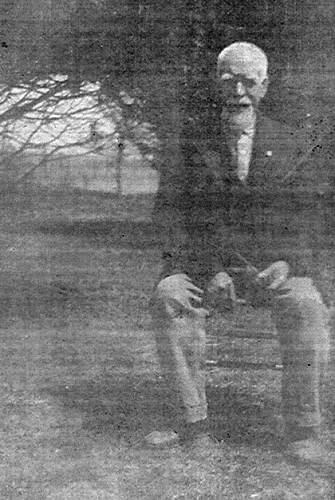
05 Daniel Heafey : 1846 - 1916

06 James Skinner The farm was inherited by Helen’s father, Joe Heafey (photo 07), and that is where she was raised.
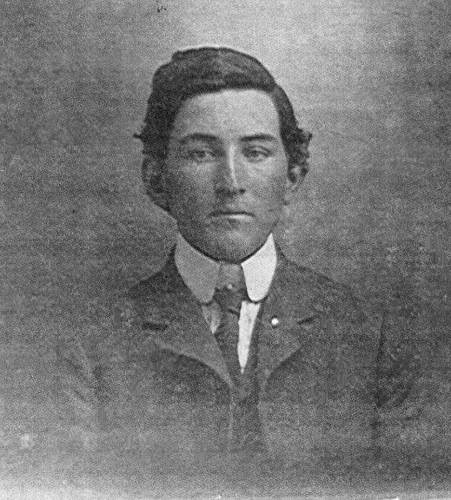
07 Joseph M. Heafey : 1886 - 1976 This story is very interesting; you can read it on a previous Progress Notes from last year.
Helen’s maternal ancestors are of the Wenzel/Artz families who settled in the area where Helen now lives on the old Skinner/Heafey farm. The Wenzel home still is standing on the opposite side of Highway 52 just a mile or two north of where Helen lives (photo 08).
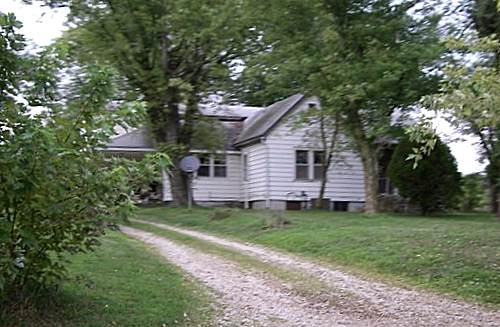
08 Konrad Wenzel Home The Artz home is also still standing a short distance north of the Wenzel home on Highway 52 (photo 09).
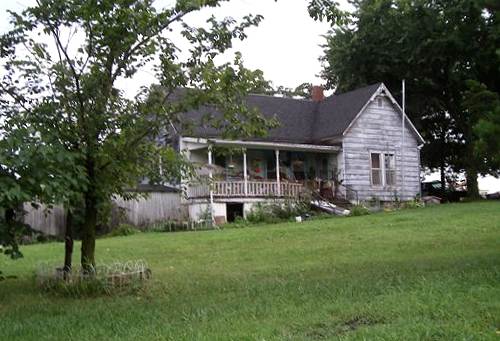
09 John Artz Family Home This general area is just a mile or so south of the Highway 52/54 intersection.
All my life I had known of the Artz/Wenzel Cemetery but never could locate it. I knew it was found just a mile north of the Skinner Tomb on the west side of Highway 52 but look as closely as I could, I never did see it from the window of my car as I was driving by that area. So the other day I visited Helen to gather information about the Artz’s and Wenzel’s but especially I wanted her to get in my car and tell me exactly where to stop to visit the cemetery.
On arriving at Helen’s home, which is located near the original family home where her son, Gerald, now lives, Helen and I reviewed the history of the Artz/Wenzel side of her family. Here is what she told me:
Artz /Wenzel Families
Helen Schulte
John and Christine Shaeffer Artz left their native Germany and landed in New York on 12 October 1872 with their five children: Mary, Konrad (J.K.), Christine, John P. and Catherine.
Note: Here is a photo of the original John Artz/Christine Shaeffer Artz family followed by the names of those in the photo (photos 10 and 11):
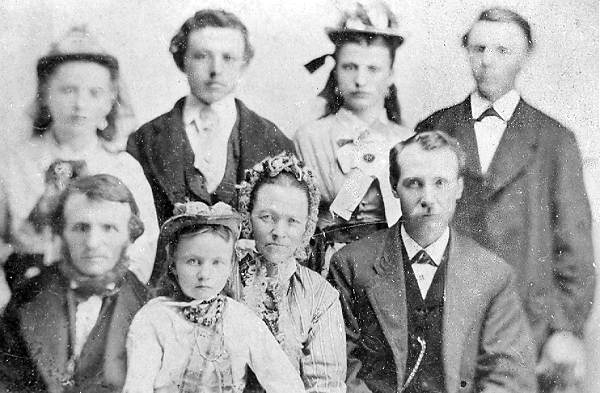
10 John Artz Family
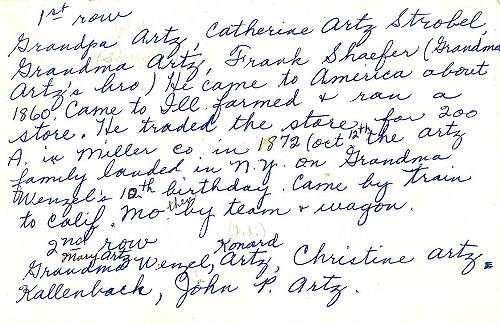
11 John Artz Family Caption If you have difficulty reading the names scanned off the back of the photo here they are typed:
First Row: Grandfather Artz, Catherine Artz Strobel, Grandmother Artz (Christine Schaeffer Artz), Frank Shaefer (Grandmother Christine Artz’s brother)
Second Row: Grandmother Mary Artz Wenzel, Konrad Artz, Christine Artz Kallenbach, John P. Artz
Frank Shaeffer, Christine’s brother, had come to America circa 1860 and apparently had done quite well, as he had a store in Illinois. He wanted his sister and family to come to this new “land of opportunity” so he traded his store for 200 acres in Miller County, a few miles south of Eldon in 1872. Perhaps he had heard about the booming town of Aurora Springs.
Frank Shaeffer, John and Christine Artz and their family, traveled to California, Missouri. Then by team and wagon on to the place which was to be their home for many years. After getting the Artz family settled, Frank Shaeffer returned to Illinois. As it often happened in earlier days due to a paucity of communication, the Artz family lost contact with Mr. Shaeffer and the farm remained in the Artz family for three generations.
The Artz children grew up and married: Mary Artz married Konrad Wenzel, Konrad married Sally Haynes, Christine married John Kallenbach, John P. married Louise Kallenbach, and Catherine married Henry Strobel.
Konrad Wenzel, my grandfather, came to America from Meinnigens, Germany in 1882 with his brother, Sebastian, because he didn’t want to be in the German Army and hoped to seek his fortune.
Konrad first went to Colorado with his step mother’s brother, a Mr. Shoup, to work in the gold mines. He worked there for a year and saved some money, but the winter was too severe and the wild animals were so bad he decided to come to Tuscumbia, Missouri to seek work from Tony Weitz, who at the time was a blacksmith located just across the road from the old Tuscumbia bank overlooking Shut In Creek. Tony had previously written Konrad while Konrad was still in Germany telling him that he was hiring four or five blacksmiths for his business. Since Konrad had already apprenticed for two years as a blacksmith he thought he could always work at that as a trade.
Konrad came by train to Jefferson City and on to West Aurora. By then, he had only a dollar left! Charlie Crane was the agent and told Dave Taylor about Konrad. Dave said he would take Konrad by horse to Tuscumbia, a distance of ten miles or more. When Konrad offered to give his last dollar to Dave, he refused it saying that Konrad needed it worse that he did. Even though Conrad had to leave his wooden trunk with all his worldly belongings at the depot in West Aurora, he was near the place where he was to spend the rest of his life.
Note: Helen has this trunk in her possession now; it travelled all the way from Germany to Miller County by way of Colorado (photo 12):
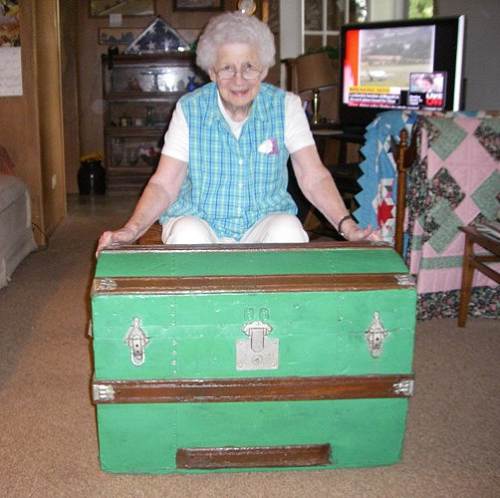
12 Helen with Konrad Wenzel Trunk Tony Weitz really did not need any help but said Konrad could go to work for $6.00 a month, room and board. But Konrad Wenzel’s luck was to improve, because while he was in Tuscumbia, he became acquainted with and worked for Ed Kallenbach, a top notch wagon maker, among other things. Ed’s sister, Louise, was married to John P. Artz and through John and Louise, Konrad Wenzel met and married Mary Artz, John’s sister, on October 12, 1884 at Aurora Springs. So, two short years after coming to America, Konrad was ready to settle down to become a full fledged American, husband, and father. Konrad and Mary did not have a place to live so they moved in with her parents, John and Christine Shaeffer Artz. They remained there for the birth of Christine and Lena. When Christine Wenzel died in 1894, at six years of age, John and Christine Artz fenced off a plot of ground and buried the little girl. That was the beginning of the Artz – Wenzel Cemetery and was to become the final resting place of John and Christine Shaeffer Artz, Konrad and Mary Artz Wenzel, infants of Konrad and Mary, Sebastian Wenzel and wife, and Anna Strobel Wenzel.
Lena Wenzel (photo 13), daughter of Konrad and Mary Artz Wenzel, married Joe Heafey. They were my parents.
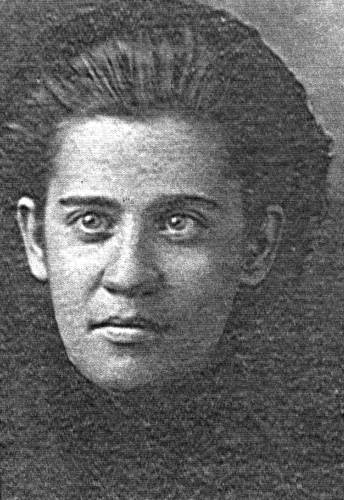
13 Lena Wenzel Heafey : 1890 - 1923 Thanks Helen for that biographical history of the Artz/Wenzel families and your relation to them.
Here is a photo of the Konrad Wenzel family (photo 14).
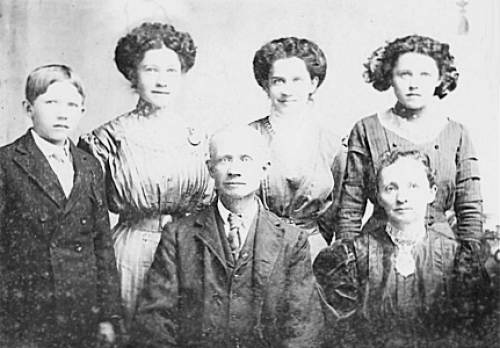
14 Konrad Wenzel Family Here are the names listed on the back of the photo:
Seated: Konrad and Mary Artz Wenzel, Behind: Carl Wenzel, Marie Wenzel Cain, Lena Wenzel Heafey, Minnie Wenzel Cain.
After Helen gave me the biographical details of her maternal family we drove over to the Artz/Wenzel cemetery. Even though it is “spitting distance” off of Highway 52 on the west side, the trees along the road side completely hide it. It is very easy to pass by and miss the location of the cemetery. However, with Helen’s help I stopped at the right place and we pulled off the highway. I snapped a photo of Helen at the entrance (photo 15):
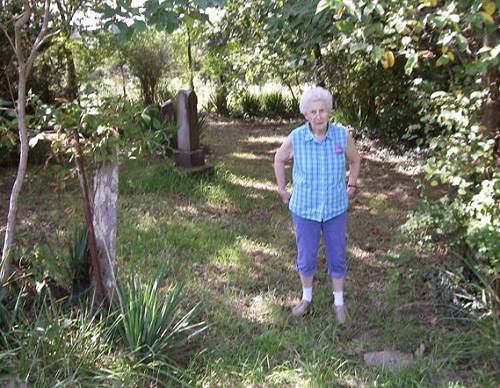
15 Helen at entrance to Artz Wenzel Cemetery At the tombstone of the Artz patriarch, John Artz, father of Helen’s grandmother, Mary Artz Wenzel (photo 16):
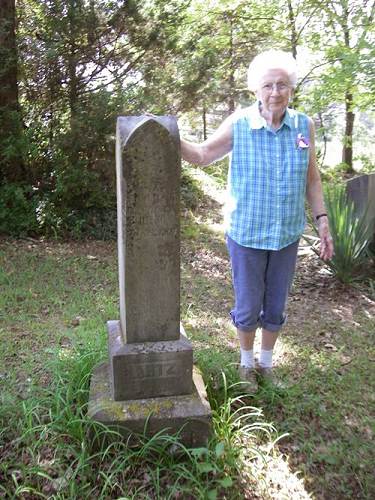
16 Helen at tombstone of John Artz And at the tombstone of Konrad Wenzel, Helen’s grandfather, who had married Mary Artz (photo 17):
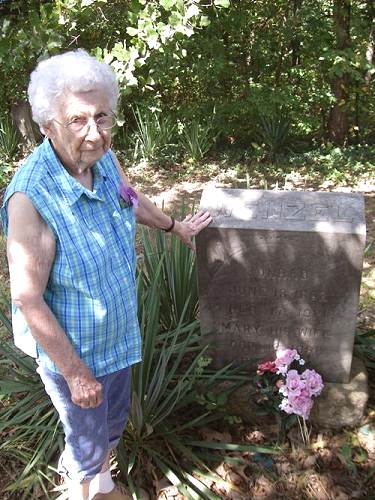
17 Helen at tombstone of Konrad Wenzel It was their daughter, Lena Wenzel, who married Helen’s father, Joe Heafey. I also took a photo of the tombstone of the first person buried in the Artz/Wenzel cemetery, that of Christine Wenzel, daughter of Konrad and Mary Artz Wenzel, who died as an infant (photo 18).
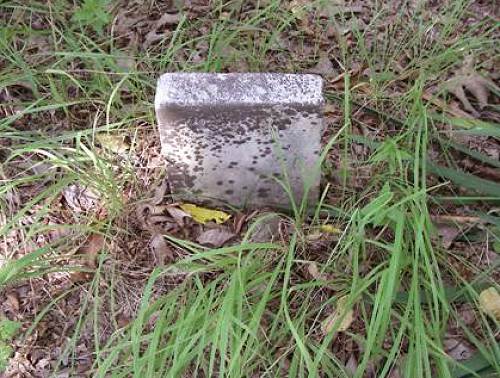
18 First Burial : Christine Wenzel (Infant) On returning to Helen’s home we lingered a while at the old bent Oak Tree in her front yard. It is one of the largest oak trees I have ever seen and more than that, it is a “bent tree,” one that supposedly was bent more than two hundred years ago by Indians as a directional sign for others to follow (photo 19).
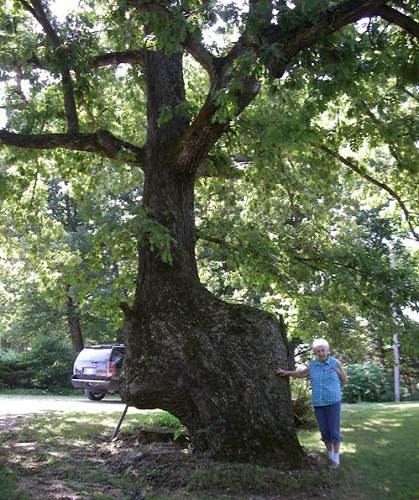
19 Bent Tree on Helen's Home Farm You can read more about the bent tree Indian trail marker at this website.
Helen also showed me some interesting family artifacts. The first is this iron metal tool which Helen called a “horse pry” (photo 20).
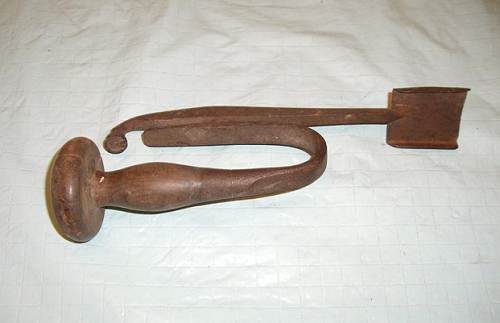
20 Konrad Wenzel Horse Pry It was used for cleaning horse hoofs, she thought, and was owned by her grandfather, Konrad Wenzel. The other interesting family heirloom is this old scale used by Helen’s uncle John K. Artz, who had a store in Aurora Springs (photos 21 and 22).
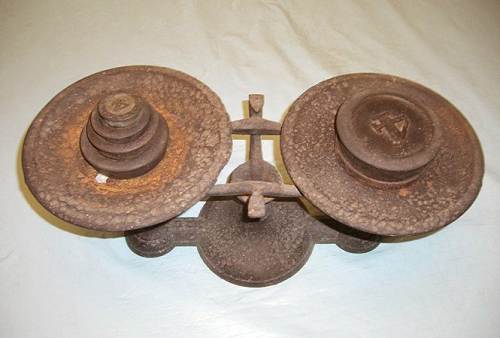
21 J.K. Artz Scale
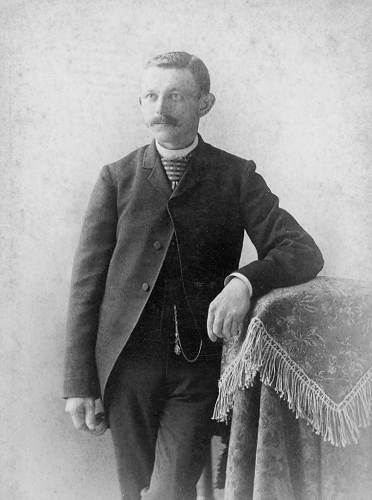
22 J. Konrad Artz - Uncle Coon Store in Aurora Springs - 1878 She said his store specialized in selling “bitters.” You can read a fascinating account of the history of “bitters” at this URL on Wikipedia:
http://en.wikipedia.org/wiki/Bitters
To get some perspective of the relationship of the Artz, Wenzel and Heafey families’ properties the next two photos show first the entire T41N R15W township which contains Aurora Springs and second a telescoped look at the pertinent sections where the farms were located (photos 23 and 24).
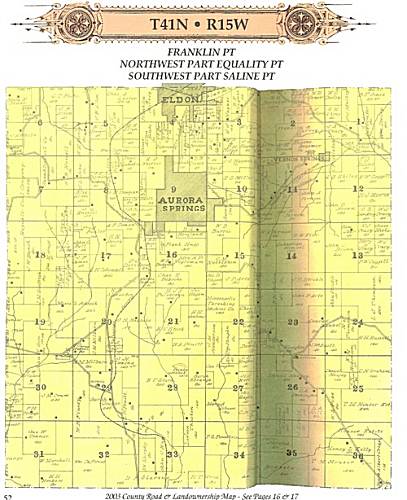
23 Plat Map : T41N R15W
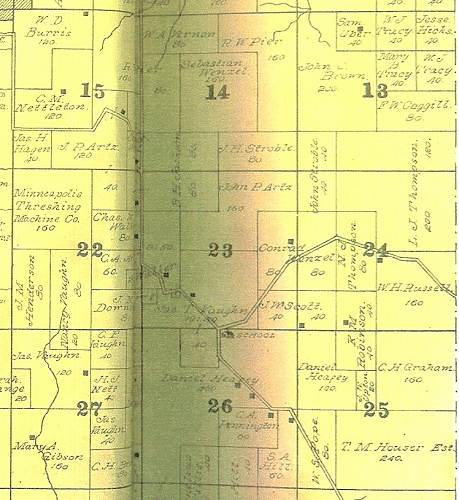
24 Plat Map : T41N R15W - Focused
Click image for larger viewAs you can see, the families lived close to Aurora Springs which up until the late 1800’s was the major town in the area. However, after the railroads decided to go through Eldon and after the passion had subsided regarding the purported medicinal effects of the spring at Aurora Springs the town quickly began to be abandoned. But because it once was a very thriving community is the reason most likely that John K. Artz opened his store of “bitters.”
Before leaving I asked Helen to summarize for us her life story. She has been involved in some form of public service all her life and certainly was my favorite teacher when I was in school at Tuscumbia:
Autobiography of Helen Heafey Schulte
By Helen Schulte
I was born November 23, 1918, the second child of Lena Wenzel and Joseph Heafey (see photo 07 and photo 13).
That was twelve days after the end of WWI. I attended Skinner School for eight years followed by four years at Tuscumbia High School. Then I attended Warrensburg Central Missouri State Teachers College for more than seventy hours credit. My Bachelor of Science in Education was awarded to me at Lincoln University of Jefferson City in 1959. From there I went to the University of Missouri in Columbia where I earned a Masters of Education degree in 1966. Since then I have earned an additional fifteen credit hours.
I spent my career in the teaching profession first beginning at Skinner one room school where I taught three years. From there I went to Sanning one room school teaching for five years followed by Central Grade School in Kansas City, Kansas for one year. I returned to Miller County the next year to teach at Tuscumbia grade school for six years. After that I taught in the Eldon school system for two years following which I and Leonard moved to Columbia. I taught for twenty years in the Columbia School system from which I retired. My last year of teaching, 1981, I was nominated for teacher of the year by the Columbia School System. I still loved teaching but thought after thirty seven years it was time to move on to something different with my life.
I married Corporal Leonard Schulte on April 1945 (photo 25).
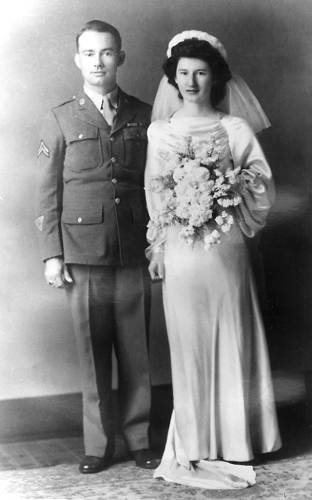
25 Leonard and Helen Heafey Schulte Wedding : 28 April 1945 Our first son, Dan, was born September 1946 and our second son, Gerald, was born April 1948. Both sons live on the original Heafey family farm and I see them daily. I don’t know how our lives could be any better except for the fact that my husband, Leonard, passed away November 1997. We had celebrated our fiftieth wedding anniversary in April of 1995 (photo 26).
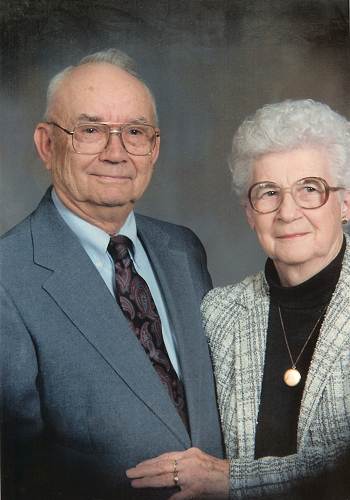
26 Fiftieth Wedding Anniversary : April 1995 Now I spend my time doing volunteer work at church, and at the Miller County Museum plus running the sweeper occasionally or other household jobs. Just recently my son ordered a computer and brought it to me saying, “Mom, I want you to learn how to operate it.” Well, I’m still trying to learn a few things and that was three months ago. Still lots to learn! But it is awesome to know so much information is out there!
Thanks Helen.
Last week the children of Waldo and Eula (Popplewell) Steen hosted a reunion of their family and extended relatives at the museum (photo 27).
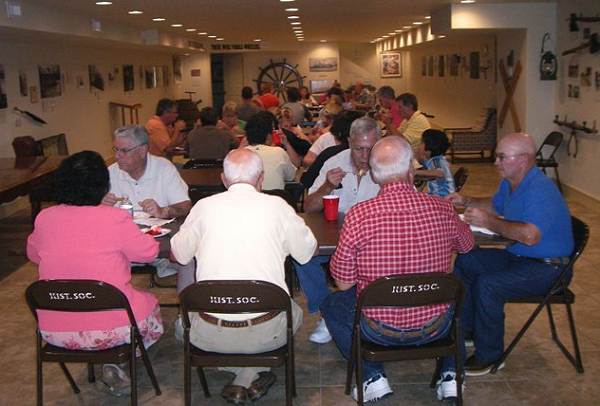
27 Steen Popplewell Reunion A group photo of the children of Waldo and Eula was taken (photo 28).
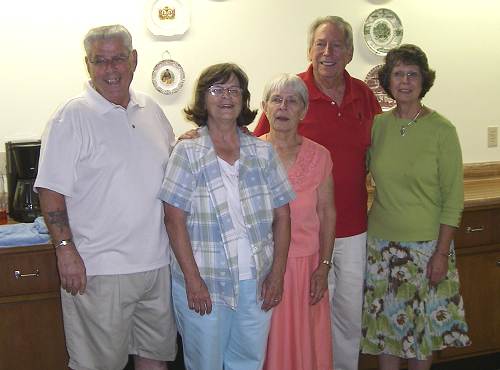
28 James Steen, Marylin Whitaker, Alice Tyler, Sherril Steen and
Eula Maye Bond (Note: Carol Elseman was Absent) Approximately eighty members were present to enjoy a pot luck dinner as well as a tour of the museum. We were very thankful to the family for its donation of nearly $1,500 dollars. Without community financial support we could not operate our museum since all depends on volunteer help and the financial donations of those who care about the history of Miller County.
Also we were very honored that the Steen family has offered to the museum the genealogical records compiled by Janet C. Steen, recently deceased daughter of Waldo and Eula Steen, as well as the diaries of Waldo Steen. These records will be of great interest to those interested in obtaining historical and genealogical information about the extended Steen family.
One of the most interesting areas in our museum is the replica of one of the old one room school houses which years ago were fairly evenly distributed throughout the county. We have our replica school room furnished with original student desks, books, wall hangings, maps, teacher’s desk, teacher’s bell, flags, and an old pot bellied stove, all once used in Miller County one room schools (photo 29).
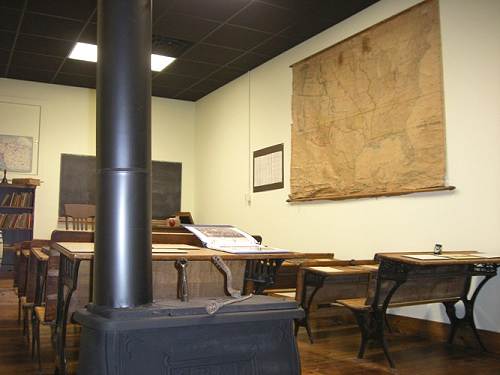
29 Replica of One Room School Regularly, we rotate group photos of students from several of the various old schools. These old class photos are one of the most interesting items of all to those who tour the museum. Many times a visitor can find a relative of long ago pictured in one of the many school group photos we display.
Several years ago Peggy Hake (photo 30), who has studied the history of our one room schools, was interviewed by Lorie Kiso of the Three Rivers Electric Cooperative about the history of the one room school.
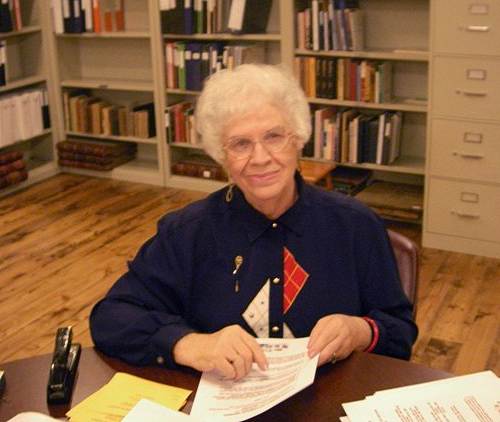
30 Peggy Hake The interview was printed in a publication distributed by Three Rivers. This article presents a good summary of some of the interesting history of how we educated our children several generations ago so I thought it might be of interest to some readers:
Reading, writing, ‘rithmetic and preservation of history
Lorie Kiso
From “Around the Circuit” a publication of Three Rivers Electric Cooperative
It stands alone, most often near a dusty stretch of county road. Many of the thin paned windows are broken, and the ones that aren’t are coated with an opaque layer of dust that has formed over the years. The wind whistles about the heavy wooden front door which hangs only by a bent hinge. The floorboards on the front porch have rotted since the time zealous children made their way to the little country school.
The little country schools in Miller County have been all but forgotten. Many of them have been torn down to make way for new homes or pastures; some are in such disrepair that the timbers are piled like pick up sticks; some are used for storage of hay; and others have been renovated into homes.
Peggy Smith Hake, a well known historian in the county, has spent many years researching the genealogy of her family and others in the county. She has documented some of the county’s history in the three books she has authored, as well as numerous magazine and newspaper articles. She has written about the lives of pioneer families, the history of the Iberia Academy (a college in Iberia in the early 1900’s) and the town, and most recently has decided to record the history of the country schools with photographs, historical documents, and reminiscences of teachers and students.
“These schools hold fond memories for people. They had to be special for people to want to continue to meet every year,” she says, noting that more and more of the students from these country schools are hosting reunions each year. “There is still an interest. Some former students want to go back. The good old days really were the good old days then. The use of photographs and of writings is the best way to preserve this history,” Peggy says.
The history of these schools dates back at least to the formation of the county in 1837. According to her research, Section Number 16 in each Township was to be used for school purposes. The land would be sold and the money would go to building schools. Early on, the schools in Miller County were built very far apart. Sometimes, they were built so far apart that the children were unable to attend often enough to get a “proper” education, she says.
In the early 1900’s, more schools were built so the children would not have to walk more than four miles to obtain an education. “Some of the schools were not more than two miles apart,” she said.
Note: For a more detailed description as to how the schools were located when they were increased in number refer to our historical school website.
The names of some of the schools are just as interesting as the history of the school itself. There were some schools that were named after the landowner, some schools were named after towns, and some were named for a creek or stream nearby. One such example is the Rabbit Head School which was located on Rabbit Head Creek in Iberia.
While interviewing a teacher from the Clark School, Peggy Smith Hake found out that the duties of the teachers were much different than they are today. “It was a completely different life,” she said.
The teacher who was interviewed boarded with a family in St. Anthony. She arrived at the school every morning between 6:30 and 7 a.m. to build the fire in the pot bellied stove. “She was also the janitor and many times she had a pot of beans cooking on the stove to supplement lunches the children brought from home,” she said. “At night she had to clean up and bank the fire in hopes of it holding overnight, then she would go back to the family she was boarding with.”
A feat which Peggy considers “amazing” was the fact that a teacher had to teach eight different grade levels. Those were the days when the older children would help with the younger ones. “It was quite different,” she says.
Peggy attended the Iberia school but she says the country school memories of her mother and aunts are still very vivid. “My mother and her sisters attended the Curry School, and I have gone to the Curry School reunions with them for the past two years. They reminisce about their school days. Those memories are something to record.”
While the preservation of memories is important to her, preservation of buildings is significant, but not easily done. “There are so many that won’t be preserved. It’s too bad there can’t be one school house somewhere that could be preserved.”
The Miller County Historical Society, of which Peggy Smith Hake is a member, has an exhibit of a country school at its Tuscumbia museum. It contains an old teacher’s desk obtained from the old White School in Osage township, student desks of varying size depending on the grade level, old books, a very old map of the U.S. hanging on the wall, an old pot bellied stove, old blackboard, a hand bell, and many other items used by teachers in those days. School children who tour the museum are impressed with the school exhibit, she says.
“I certainly hope there will be someone to carry on,” she said of her work with genealogy and the preservation of county history. “I hope there will be someone to have an interest to preserve and protect these pieces of history.
“It’s hard to look to the future without looking into the past,” says Peggy Smith Hake. “We often forget and overlook our heritage. One should always look back with pride and try to preserve that heritage for the future generations.”
We have a number of photos of old Miller County schools at our school website listed above. For a quick review I have copied here from various sources several photos of the over ninety schools we once had in the county (photos 31 through 48):
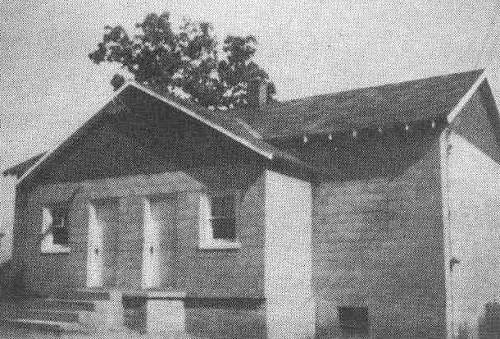
31 Aurora Springs School
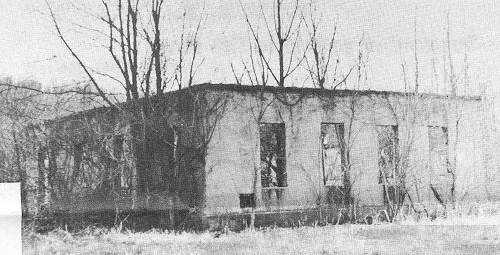
32 Bagnell School
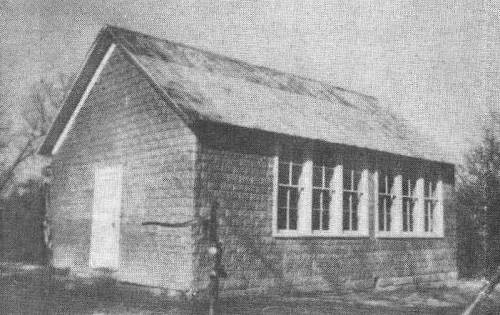
33 Berry School
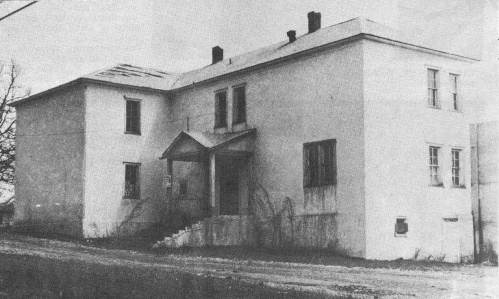
34 Brumley School
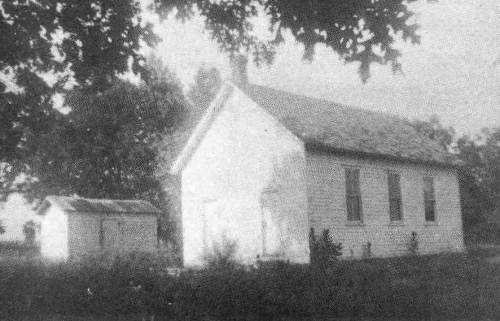
35 Cooper School
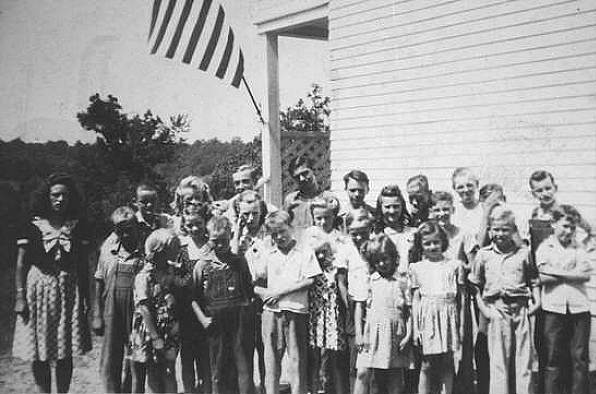
36 Curry School Children
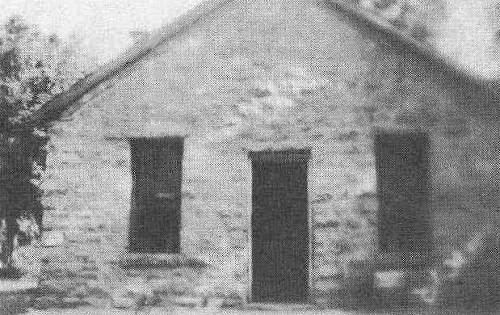
37 Dog Creek School
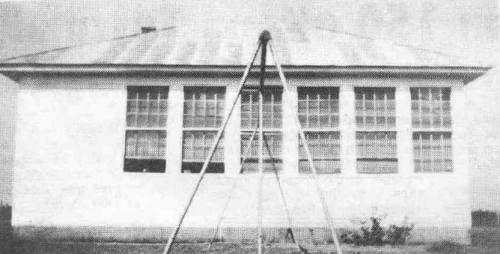
38 Mace School
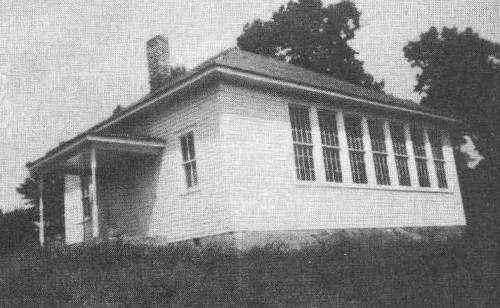
39 Madden School
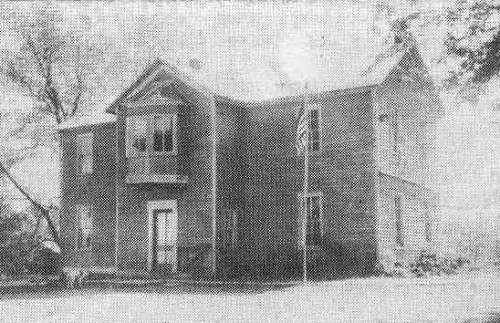
40 Mary's Home School
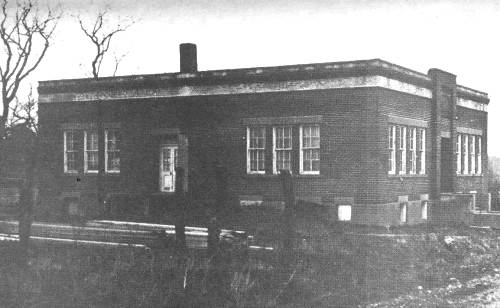
41 Olean School
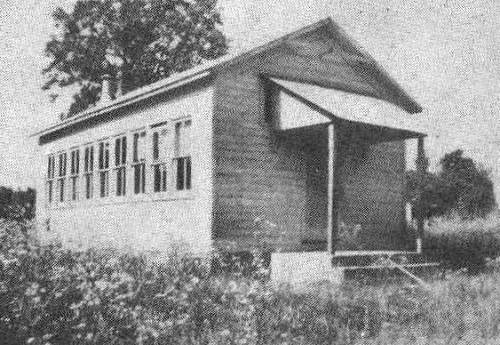
42 Post Oak School
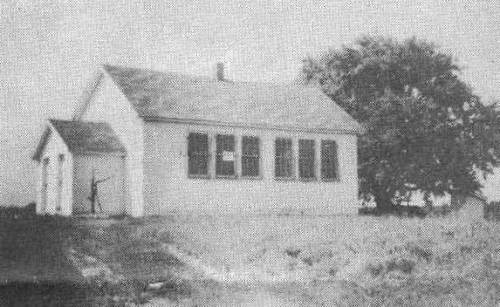
43 Rocky Mount School
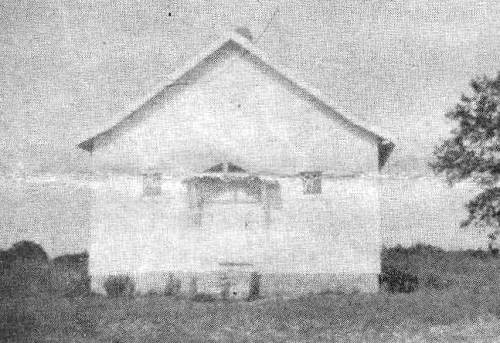
44 Skinner School
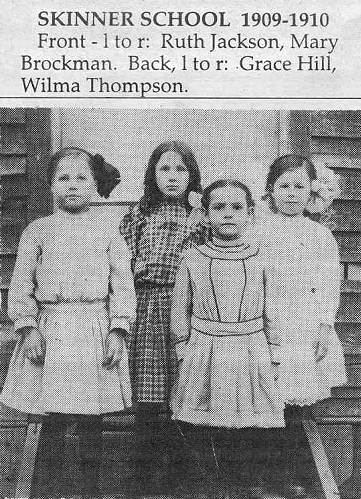
45 Skinner School Children - 1909
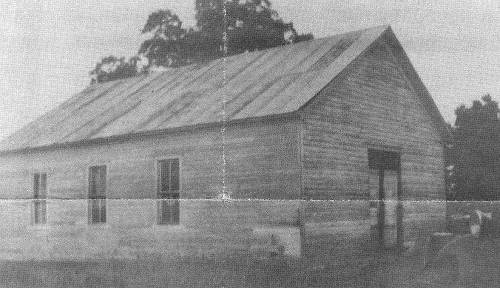
46 Topping School
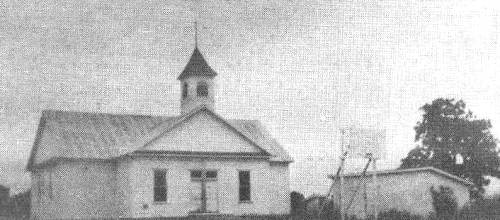
47 Ulman School
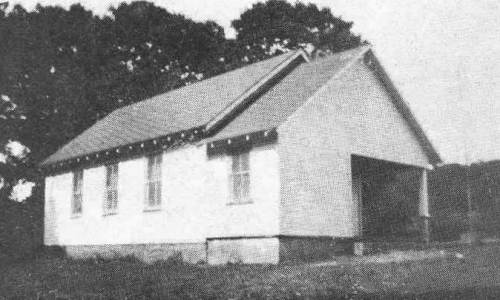
48 Vernon School One of the customs of the old one room school tradition was that the teachers, if female, had to be single and obey a number of rules regarding dress and behavior. I have seen some of the old school record books in which the rules are recorded as recommended by the local school board committee, usually consisting of four or more men (no women!). Here is a photo I took of one list containing some of these rules (photo 49).
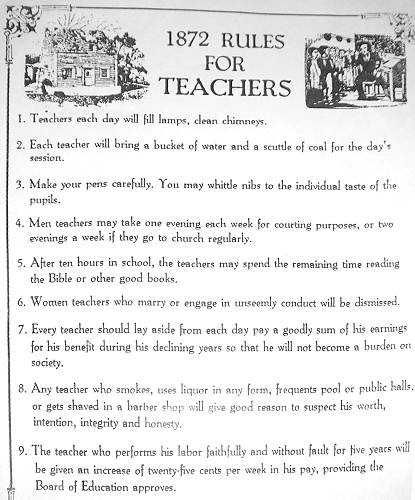
49 Rules for Teachers at One Room Schools
Click image for larger viewWe have an ongoing program to collect, clean, and microfilm the old school record books for our library. If any reader knows of one of these record books which might be available for microfilming for our library we would appreciate being notified. On our staff we have some volunteers dedicated to this project including Karen Smith, Doris Wiggins and Nancy Thompson. We are very grateful for their work in this area. Don’t hesitate to take a look at our school website listed above. Many more old schools plus their histories are located there.
That’s all for this week.
 Joe Pryor
|



